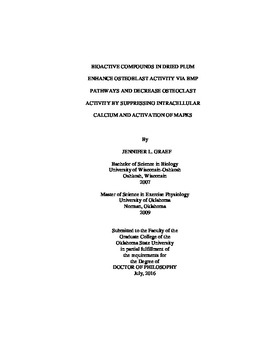| dc.contributor.advisor | Smith, Brenda J. | |
| dc.contributor.author | Graef, Jennifer L. | |
| dc.date.accessioned | 2018-03-13T18:15:42Z | |
| dc.date.available | 2018-03-13T18:15:42Z | |
| dc.date.issued | 2016-07 | |
| dc.identifier.uri | https://hdl.handle.net/11244/54530 | |
| dc.description.abstract | Dietary supplementation with dried plum has been shown to improve bone health in clinical and pre-clinical studies. This is due to the fruit's anabolic and anti-resorptive properties. A crude ethanol polyphenolic extract from dried plum has been found to enhance bone formation and suppress bone resorption in vitro and in vivo, but the components within this crude extract that exert these anabolic and anti-resorptive effects are not known. These studies were designed to identify the most bioactive components of the total polyphenolic extract of dried plum in enhancing osteoblast activity and reducing osteoclast activity under normal and inflammatory conditions. In addition, mechanisms by which the bioactive components of the polyphenolic extract affect osteoblast and osteoclast function were examined. Extraction with increasing methanol concentration was used to yield six polyphenolic fractions from the total polyphenolic extract of dried plum. It was determined that the two fractions with the lowest organic content (i.e., DP-FrA and DP-FrB) enhanced osteoblast activity under normal conditions in primary bone marrow-derived osteoblasts. This was due to increased BMP signaling and Runx2 expression. DP-FrA and DP-FrB did not have as robust of an effect on osteoblast activity under inflammatory conditions. The fractions with the higher organic content (i.e. DP-FrE and DP-FrF) were the most bioactive in suppressing osteoclast differentiation and activity. These fractions downregulated the expression of Nfatc1 under normal and inflammatory conditions in mono-cultures of bone marrow-derived osteoclasts, as well as under inflammatory conditions in osteoblast and osteoclast co-cultures. The downregulation of Nfatc1 was due to a suppression of MAPK and calcium signaling. In addition, the fractions downregulated Rankl expression in the co-culture system, thereby suppressing the differentiation signal to osteoclast precursors. These studies are the first to identify fractions of the polyphenolic extract of dried plum that are most bioactive in enhancing osteoblast activity and suppressing osteoclast activity in primary cell culture models. These findings provide valuable insight into the mechanisms by which dried plum improves bone health in vivo, as well as the types of dietary compounds that should be targeted for use as potential preventative or treatment measures for osteoporosis. | |
| dc.format | application/pdf | |
| dc.language | en_US | |
| dc.rights | Copyright is held by the author who has granted the Oklahoma State University Library the non-exclusive right to share this material in its institutional repository. Contact Digital Library Services at lib-dls@okstate.edu or 405-744-9161 for the permission policy on the use, reproduction or distribution of this material. | |
| dc.title | Bioactive compounds in dried plum enhance osteoblast activity via BMP pathways and decrease osteoclast activity by suppressing intracellular calcium and activation of MAPKs | |
| dc.contributor.committeeMember | Lucas, Edralin A. | |
| dc.contributor.committeeMember | Clarke, Stephen L. | |
| dc.contributor.committeeMember | DeSilva, Udaya | |
| osu.filename | Graef_okstate_0664D_14694.pdf | |
| osu.accesstype | Open Access | |
| dc.type.genre | Dissertation | |
| dc.type.material | Text | |
| thesis.degree.discipline | Nutritional Sciences | |
| thesis.degree.grantor | Oklahoma State University | |
